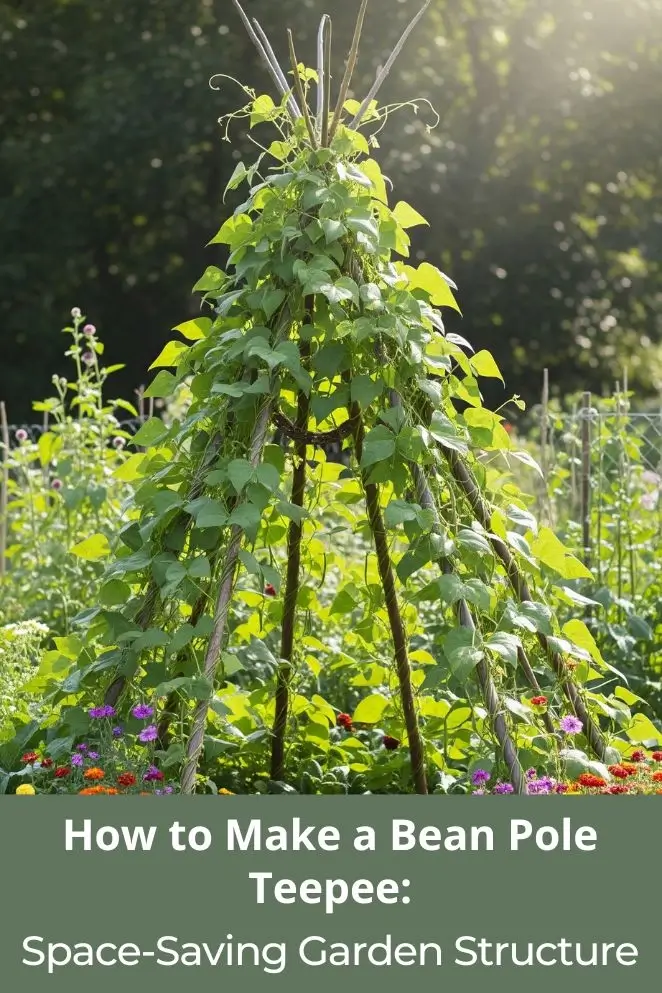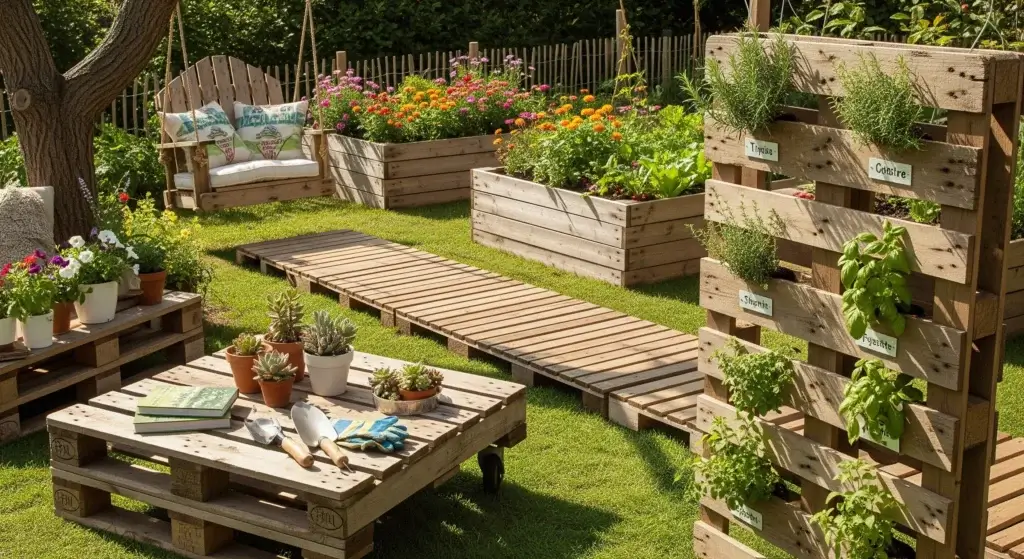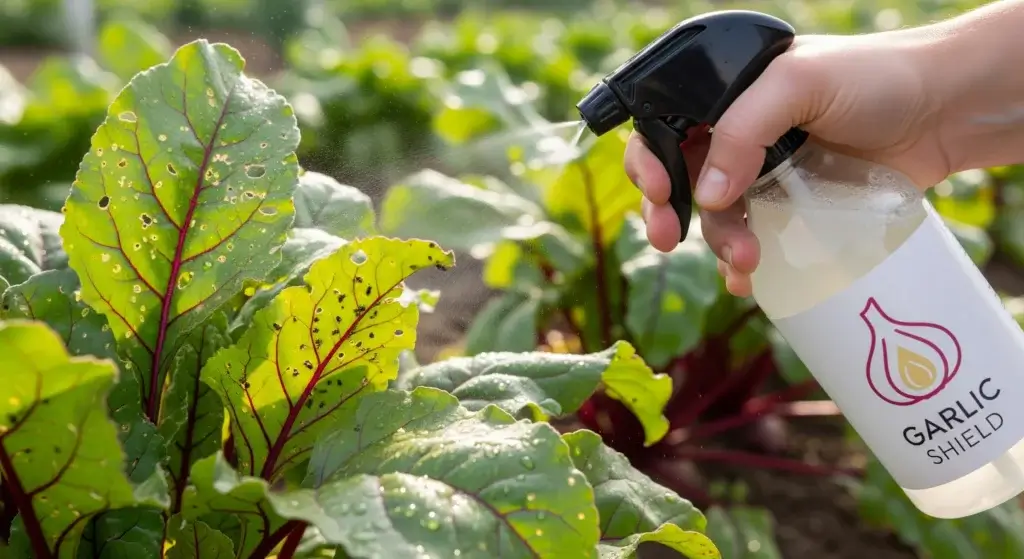
Growing your own beans is awesome but tiny yards and flimsy supports kill the vibe.
A bean-pole teepee is the classic, space-saving fix — easy to build, looks cool, and gives vines solid support so you get bigger harvests with less fuss.
Picture grabbing a few bamboo poles, building a teepee with a friend one afternoon, and a few weeks later hauling in a basket of beans — this guide shows you how to build and care for a teepee that keeps producing for years.
What Is a Bean Pole Teepee and Why Should You Build One?
Think of a bean pole teepee like a giant plant fort — it’s a cone-shaped frame made from tall poles stuck in a circle and tied at the top.
Gardeners have been using this trick for centuries to grow climbing beans like pole beans, runner beans, and even lima beans.
And honestly? It’s way cooler (and smarter) than just sticking beans in rows or leaning them on a single pole.
The main perks of a bean pole teepee are:
- Space efficiency: A teepee about 6 feet across can hold 8–12 bean plants, all packed into one little circle..
- Better airflow: The open design lets air move freely, so your beans don’t get gross from fungal diseases. Basically, your plants get to breathe.
- Easy harvesting: Instead of crawling on the ground like you’re looking for lost change, your beans dangle right at eye level — grab and go.
- Super sturdy: Built right, a teepee can handle strong winds and the weight of tons of beans without collapsing like those sad single poles.
- Budget-friendly: You don’t need fancy metal trellises. A few bamboo poles or branches from the backyard, and boom — you’ve got a bean mansion.
Essential Materials and Tools for Your Bean Pole Teepee
Before you start building, round up your supplies like you’re prepping for a DIY quest.
Trust me — the sturdier your stuff, the longer your bean fort will last.
A wobbly teepee? Total heartbreak when the wind knocks it over.
- Read also: DIY Greenhouse Trellis: Transform Your Garden Space
- Read also: Step-by-Step Guide: DIY Butterfly Garden Design Ideas
Materials needed
- 8–12 poles: Go for bamboo canes (8–10 feet tall), cedar posts, or even straight branches you scavenged from the yard.
- Strong twine or rope: Hemp rope, nylon cord, or just heavy-duty garden twine to lash the poles together.
- Wire or zip ties: Not mandatory, but clutch if you live where the wind likes to show off.
- Mulch: Cover the base with straw, wood chips, or shredded leaves — keeps weeds down and locks in moisture for your beans.
Tools required
- Measuring tape: To space your poles evenly in a circle. Unless you want a lopsided teepee that looks like it’s about to tip over.
- Garden spade or post-hole digger: For making holes so your poles don’t just sit on top of the soil like sad sticks.
- Pruning shears: To snip off extra twine or trim the top if your poles look uneven.
- Rubber mallet: For tapping poles into the ground without breaking them (also doubles as a stress reliever — bonk bonk).
Step-by-Step Construction Guide
Step 1: Choose the perfect location
Picking the right spot is everything. Beans are basically sun addicts — they need 6–8 hours of direct sunlight to be happy.
So skip the shady corners; your teepee deserves the spotlight.
Also, beans hate having “wet feet,” so avoid soggy, low-lying areas where rain collects (trust me, root rot is gross).
A breezy spot is fine, but don’t plop it right where the wind howls strongest unless you want your teepee doing a backflip.
Bonus points if it’s near a hose — carrying buckets of water across the yard gets old real quick.
And make sure you leave at least 3 feet of space around it so you can walk in, harvest beans, and pretend you’re stepping into your own little green fortress.
Step 2: Determine size and mark your circle
For most backyards, a 6-foot-wide teepee is perfect — big enough for a good harvest, but not so giant it feels like you’re building a circus tent.
This size usually fits 8–10 poles spaced 2–3 feet apart.
The easiest way to mark your circle? Grab a stake, tie on a 3-foot string, and swing it around like a compass to make your outline.
Bigger teepees (8 feet across) are bean factories but need taller, beefier poles.
Smaller ones (like 4 feet across) are super cute for kids or tiny spaces, but don’t expect buckets of beans.
Step 3: Prepare and position the poles
Check your poles first — no sharp splinters or weird bumps that’ll snag your hands or shred your plants.
If you cut your own wooden poles, let them dry for a few weeks so they don’t shrink and loosen later.
Dig holes 8–10 inches deep at each mark on your circle.
Drop in the poles so they lean inward about 15–20 degrees — that lean is what makes the magic teepee shape.
Think “leaning in for a group selfie,” not “standing stiff like soldiers.”
Step 4: Secure the top junction
This is the make-or-break step. Gather all the pole tops together about 7–8 feet up.
Now, lash them like your life depends on it.
Wrap strong twine or rope tight around the bundle, starting with a clove hitch (basically a grippy knot), then keep circling until it feels rock solid.
Finish with a square knot or bowline.
Live in a windy place? Toss in some wire ties or even hose clamps for extra muscle.
If the top comes loose, the whole teepee turns into a bean avalanche — and nobody wants that.
Step 5: Add horizontal support strings (optional)
Not required, but highly recommended.
Tie string between poles in a spiral, starting about 2 feet up, then every 12–18 inches as you climb higher.
Picture it like building a bean ladder.
Smaller-vined varieties especially love this — without it, some vines just flap around in the wind like lost kites.
Step 6: Prepare the growing area
Clear weeds and grass from inside the teepee and about 2 feet around the outside.
Then, spread 2–3 inches of mulch (straw, wood chips, shredded leaves).
Mulch is like the bean plant’s mattress — keeps the soil cozy, holds in water, and slowly breaks down to feed them.
Before planting, pull the mulch back in 6-inch circles at the base of each pole, giving each bean plant its personal growing spot.
Planting and Maintaining Your Bean Teepee
Selecting the right bean varieties
Not all beans are climbers — so skip bush beans and go for pole types that love to scale.
Classics like Kentucky Wonder give you tons of tasty pods, Scarlet Runners look like they belong in a fairy tale with their red flowers, Romano Pole Beans are Italian and deliciously flat, and Yard Long Beans basically flex by growing absurdly long.
Planting techniques
Drop 2–3 seeds near each pole, about 4–6 inches out, an inch or two deep.
Make sure your soil is warm (60°F+), usually a couple weeks after the last frost.
Water gently, keep the soil moist, and within a week or so — boom, sprouts.
Watching them pop up feels like hitting the jackpot.
Ongoing maintenance
Check your lashings once in a while — rope loosens with rain and sun.
When vines hit 6–8 inches, help them grab the poles (beans aren’t always smart enough to find their ladder).
Keep an eye out for pests like aphids or beetles, but the open teepee design makes spotting them way easier.
And pick beans often — the more you harvest, the more the plants keep cranking out fresh pods.
Your teepee can stay productive for a solid two months if you stay on top of it.
Troubleshooting Common Issues
Leaning or unstable structure
Usually this means the poles aren’t planted deep enough or the top lash is slipping.
Re-tie that top like your life depends on it, drive the poles deeper, or add guy-wires/stakes.
Poor bean growth
Most of the time beans are just being basic — not enough sun, soggy roots, or getting choked by weeds.
Move it to full sun, improve drainage or raise the bed, keep mulch tidy, and give the soil some love.
Pest problems
The teepee helps, but aphids, beetles, and mites still show up for free snacks.
Inspect regularly, blast little pests off with a hose, pick off big beetles, and use organic sprays (insecticidal soap or neem) only if you must.
The open design makes catching trouble early way easier — use that to your advantage.
- Read also: DIY Backyard Landscaping Ideas to Transform Your Yard
- Read also: Affordable DIY Patio and Deck Ideas for Your Backyard
Conclusion
A bean pole teepee is old-school genius with modern vibes — it turns a tiny patch of ground into a vertical food factory and makes your garden look like something out of a fantasy movie.
The effort? Totally worth it.
You’ll get more beans, less back-breaking work, and bragging rights for building it yourself.
Whether you’re just starting out or already a garden pro, this setup slaps.
Start sketching it out now, and by next season you’ll be stepping into your bean fort to snack on fresh pods like it’s your own personal harvest festival.



